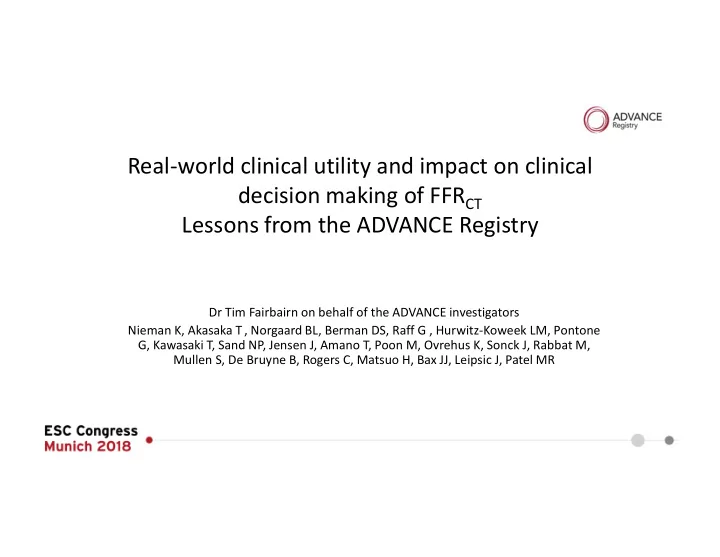

Real-world clinical utility and impact on clinical decision making of FFR CT Lessons from the ADVANCE Registry Dr Tim Fairbairn on behalf of the ADVANCE investigators Nieman K, Akasaka T , Norgaard BL, Berman DS, Raff G , Hurwitz-Koweek LM, Pontone G, Kawasaki T, Sand NP, Jensen J, Amano T, Poon M, Ovrehus K, Sonck J, Rabbat M, Mullen S, De Bruyne B, Rogers C, Matsuo H, Bax JJ, Leipsic J, Patel MR
Disclosures • Dr. Fairbairn: HeartFlow Speakers bureau • Full author Disclosures available online (European Heart Journal) • The ADVANCE Registry was funded by HeartFlow Inc., via individual Clinical Study Agreements with each enrolling institution and with the Duke Clinical Research Institute (DCRI) for Core Laboratory activities and Clinical Event Committee adjudication of adverse events
Coronary CTA For Assessment of Chest pain Coronary CT Angiography (CCTA) • Increasingly used as primary diagnostic strategy for assessment of chest pain with suspected CAD • High sensitivity but modest specificity • Improves patient outcomes compared to functional testing • High rates of invasive coronary angiography showing non-obstructive coronary disease and increased rates of revascularisation • Cannot guide revascularization alone owing to the lack of functional information
Imaging in Coronary Artery Disease Anatomical Anatomical and Functional Testing Functional Testing Stress Echo Treadmill ECG Coronary CT angiography FFR CT Stress MRI SPECT
CT Derived Fractional Flow Reserve (FFR CT ) Improves Reduces ICA showing Increases Cost saving discrimination of non-obstructive disease appropriate ischemia revascularisations Driessen et al, EuroPCR 2018 Douglas et al, EHJ 2015 Packard et al, EHJ CvImaging 2016 Hlatky et al, JACC, 2015
ADVANCE Registry • 5083 subjects undergoing CCTA with clinically stable symptoms were prospectively enrolled at 38 sites in Europe, North American and Japan between July 2015 – October 2017 • Primary Endpoint: – Reclassification rate between CCTA-based versus FFR CT -based management plans as determined by blinded core laboratory adjudication • Secondary endpoints: – Reclassification rate between CCTA-based and FFR CT -based management by site adjudication – Incidence of ICA demonstrating no obstructive coronary stenosis >50% – 90-day survival free from all cause or major adverse cardiovascular events (MACE) inclusive of MI, all-cause mortality or unplanned hospitalization for ACS leading to revascularization* * Event adjudication performed by independent Clinical Events Committee
Planned and Actual Management Management Plan Treatment Strategies Separate site and blinded core lab 1. Medical Treatment interpretation and recommendations 2. PCI • Primary management plan based on CCTA alone 3. CABG • Second ‘revised’ management plan based on CCTA + FFR CT 4. Further testing • Actual Management at 90-days
FFR CT pathway and Patient Demographics FFR CT patient pathway Population Demographics FFR CT (n=4737) Patients recruited Age (years) 66.1 (±10.3) 5083 Male sex 3134 (66.2%) CCTA not submitted for FFR CT 190 (3.7%) Hypertension 2835 (59.8%) Diabetes Mellitus 1037 (21.9%) FFR CT requested 4893 (96.2%) Hyperlipidaemia 2753 (58.1%) Angina status Not analysable Atypical 1727 (36.5%) 156 (3.2%) Typical 1025 (21.6%) Non-cardiac pain 297 (6.3%) Dyspnoea 472 (10.0%) FFR CT analysed None 1164 (24.6%) 4737 (96.8%) Unknown 52 (1.1%) Diamond-Forrester Risk 51.6 (±20.3)
Disease Burden >50% stenosis: 72.1% >50% stenosis (multivessel): 36.9% Ischaemia (FFR CT ≤0.80): 66.4% RCA LAD Median FFR CT 0.79 LCX Median FFR CT 0.88 Median FFR CT 0.87
Reclassification by Core Lab Post FFR CT Actual Management* Post CCTA Management Strategy (n=4737) Management Strategy (n=4715)β (n=4715)β β 22 post CCTA treatment recommendations were not made 66.9% reclassification * 924 (19.8%) had ICA and no revascularization
Reclassification by Site Post CCTA Post FFR CT Actual Management* Management Strategy Management Strategy (n=4737) (n=4119)β (n=4119) β β 618 post CCTA treatment recommendations were not made 63.5% reclassification * 924 (19.8%) had ICA and no revascularization
90 day Clinical Outcomes Rate of ICA, Non-Obstructive CAD and Revascularization ICA 40% ICA 19% Non-obstructive CAD 14.4%* Non-obstructive CAD 43.8%* FFR CT Stratum * No coronary stenosis ≥50% by site interpretation of ICA
90 day Clinical Outcomes MACE (MI, Death, Hospital Admission for ACS and Unplanned Revascularization) Death or MI All MACE FFR CT ≤ 0.80 FFR CT ≤ 0.80 Days P=0.0019 P=0.0077 n=3145 HR: 19.75 (1.19-326) HR: 14.68 (0.88-246) n=3145 FFR CT > 0.80 FFR CT > 0.80 n=1592 n=1592 Days Days
Limitations • Registry study – cannot exclude inclusion bias that affects all registries – ‘Real world’ • Selection bias; small percentage (6.8%) not submitted or not analyzable – No difference in groups demographics • Enrolled subjects with CAD on CTA – This is the relevant population for FFR CT • Multifaceted nature of clinical decision making – CCTA alone vs. CCTA + FFR CT , Symptom severity, anatomical location of stenosis, local practice • Only early follow up (90 days) – Further follow up planned at 1 and 3 years
Summary In an international multicenter real-world population of over 5000 patients, the addition of FFR CT to CCTA: • Changed management plans in over 60% of subjects • Was associated with low rates of invasive angiography, and good safety when FFR CT >0.80 (no MACE) • Significantly lowered the rate of anatomical (<50% DS) non- obstructive disease at ICA (14 vs 44%) with abnormal FFR CT • An inverse relationship exists between FFR CT value and likelihood of downstream ICA, revascularization, and MACE
Recommend
More recommend